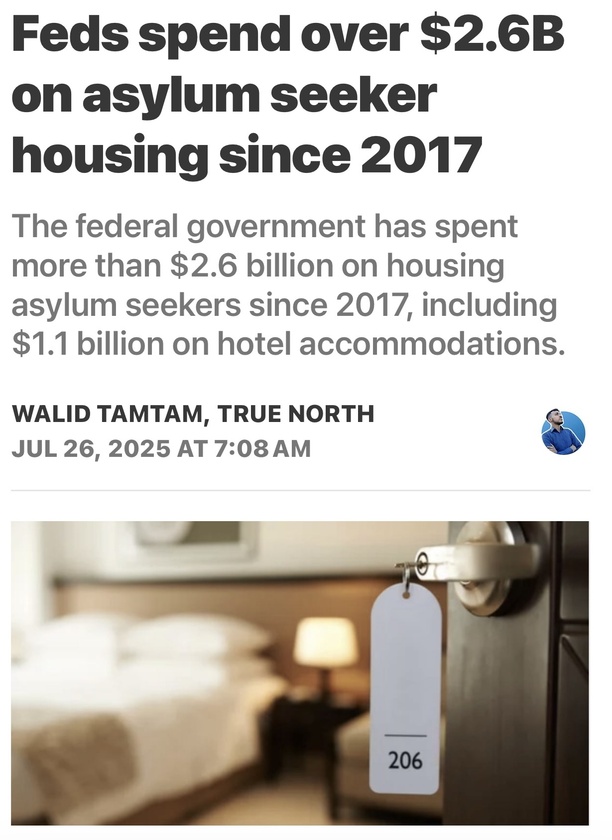
ARE YOU CANADIANS AWARE??
This is another problem for our healthcare, housing or lack of it, no jobs for our summer students & contributing tax dollars! AND now Carney has personally written letters inviting grandparents & parents in with dwindling infrastructural contributions!
The federal government has spent more than $2.6 billion on housing asylum seekers since 2017, including $1.1 billion on hotel accommodations and $1.5 billion in transfers to provinces and cities to manage shelter costs amid record-high arrivals.
Immigration, Refugees and Citizenship Canada began block-booking hotel rooms in 2017 as a temporary measure to relieve pressure on overwhelmed municipal shelters.
Since then, the hotel program has grown into a major federal expense, with thousands of claimants accommodated in dozens of hotels across Canada.
The number of asylum seekers arriving annually has climbed sharply, from 50,365 in 2017 to over 173,000 in 2024.
The majority settle in Ontario and Quebec, especially in Toronto and Montreal.
At the program’s peak in late 2023, the federal government was paying for rooms in 46 hotels nationwide, with an average per-night cost of $205.
That figure has since dropped to $132 nightly, with the number of active hotel sites reduced to five — one in Quebec and four in Ontario, serving about 500 claimants.
A March transition briefing prepared for the then-immigration minister noted IRCC was maintaining about 3,500 contingency beds and had secured $66.6 million in funding to continue hotel operations until September 2025.
To encourage movement out of hotels, Ottawa began issuing "notices to vacate" in early 2024.
Between January and March, the policy resulted in over 13,000 asylum seekers finding alternative accommodations.
Despite the effort to scale back, municipalities continue to face substantial housing-related costs.
Since 2017, Toronto has received nearly $670 million in federal support through the Interim Housing Assistance Program, followed by Quebec with $542.7 million.
In 2024, the City of Ottawa incurred $54.7 million in costs related to asylum seekers, of which $51.9 million was covered by the housing assistance program
City officials say they are awaiting confirmation of further federal support for 2025 through 2027.
Conservative immigration critic Michelle Rempel Garner said such expenditures fuel public skepticism toward the immigration system.
“When the average Canadian hears that somebody with an asylum claim is staying in a hotel, there’s a justified sense of unfairness,” she said.
“These are the types of expenditures that undermine Canadian acceptance for immigration during a housing crisis.”
Meanwhile, Ontario Premier Doug Ford says his government is preparing to bypass federal delays by issuing its own work permits to asylum seekers.
“We will be issuing our own work permits,” Ford told reporters after a summit with premiers in Muskoka, Ont. “We have authority in that area.”
Ford cited Section 95 of the Constitution Act, 1867, which gives provinces shared authority over immigration.
Ford argued that giving claimants a path to employment would help fill labour shortages while allowing them to support themselves and integrate.
“I have a tremendous amount of asylum seekers that are up in Etobicoke in the hotels, they’re healthy, they’re willing to work, but they’re just sucking off the system,” Ford said. “It’s not their fault. The fault falls under immigration.”
“They want to find a job, start off renting a condo or part of a house, and then buy a home,” he said.
Canada continues to grapple with mass immigration pressures this year, welcoming over 817,000 newcomers in the first four months of 2025, including 132,100 new permanent residents, 194,000 finalized study permits, and 491,400 work permits or extensions.
Despite Prime Minister Mark Carney’s pledge to bring immigration to “sustainable levels,” the total number of temporary residents in Canada has now surpassed 3 million, equivalent to 18.5 per cent of the private-sector workforce.

















